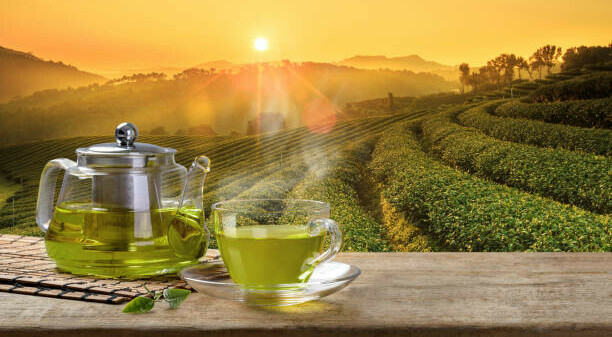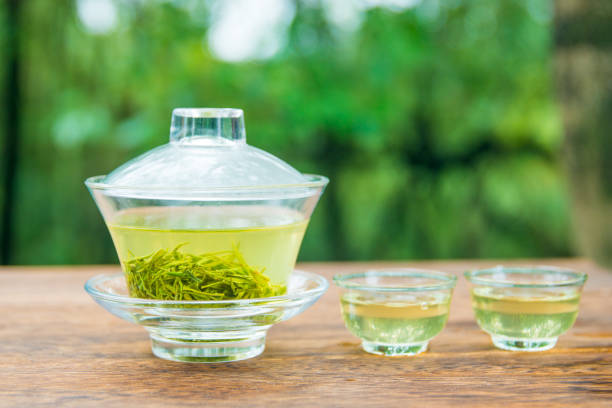So you’re interested in learning about the world of tea? Welcome to my article about the “Main Differences Between Green Tea And Oolong Tea”. I’ll help you understand the distinctions between two popular types: oolong tea and green tea. This isn’t just about brewing leaves; it’s also about the history, customs, and subtle nuances that define each type of tea. Let’s start by exploring their characteristics.
Oolong tea is a traditional Chinese tea that undergoes partial oxidation, creating a balance between green tea (unoxidized) and black tea (fully oxidized). This unique position gives it a complex flavor and a wide range of oxidation levels. Some of the most famous oolong teas are cultivated in regions like Fujian and Taiwan.
On the other hand, green tea is widely consumed worldwide and is known for its delicate, fresh characteristics. Originating in China, where it has been enjoyed for thousands of years, green tea has become a part of various cultures and is a staple in many daily routines. Examples of the diversity within green tea types include Sencha from Japan and Longjing from China.
The world of tea is evolving rapidly, and there’s a lot of potential to explore what I refer to as ‘Classic True Teas.’ These teas capture the true essence of the tea leaf, with minimal processing to retain the authentic flavor of their origins. Oolong and green teas belong to this prestigious category, originating from the Camellia Sinensis plant and offering a genuine taste of the landscapes where they are grown.
It’s pretty amazing, isn’t it? Think about the wide range of flavors, aromas, and traditions infused into each cup. In the next section, we’ll delve into how these differences are evident: the fascinating journey from leaf to cup, including the variations in their processing and the resulting nutritional content. So, let’s continue our exploration of the world of tea together.
Tea Journey from Leaf to Cup: Processing and Nutritional Content

To truly understand the essence of oolong and green tea, delving into their production and what is present in your cup is essential. I will address the differences in the production methods of these teas and their implications on their nutritional content.
It all starts with the leaves of the same plant, Camellia Sinensis. The difference lies not in the leaf itself but in how it is processed after being harvested. Green tea is quickly heated after picking to stop the oxidation process. This method maintains the green color of the leaves and preserves their earthy, grassy characteristics.
On the other hand, oolong tea is allowed to undergo varying degrees of oxidation before being heated and dried. This process can result in light to heavy oxidation, producing a range of flavors from floral to toasty. It is this variation in oxidation that distinguishes oolong from green tea.
In terms of nutrition, both teas offer their own unique profiles. They are both low in calories and rich in antioxidants, such as flavonoids, although the levels may differ due to variations in processing. This is not just about a refreshing beverage; it concerns the various compounds, like EGCG found primarily in green tea, which provide health-promoting properties.
Many people are interested in caffeine content, and both teas have a range. However, due to the longer oxidation process, oolong has slightly more due to its higher caffeine content. However, the caffeine content is significantly lower than what you would find in a cup of coffee.
Choose what resonates with you. If you are interested in the nutritional benefits, you will be glad that both teas are recognized for their positive impact on health. In the next section, I will delve into the diverse flavor profiles of oolong and green tea and their array of experiences.
A Sip of Complexity: Flavor Profiles and Consumption

You will learn about how these teas’ flavors, scents, and appearances differ significantly, even though they all come from the same plant. The unique tastes of green and oolong teas result from their distinct processing methods. Green tea is often described as light, fresh, and grassy, reminiscent of a brisk morning walk in a dew-kissed meadow. On the other hand, oolong tea can vary greatly. Light oolongs may have a delicate floral touch, while darker varieties mimic freshly baked bread’s rich, roasted notes.
The teas are visually stunning in addition to being delicious. Green tea typically has a pale green to yellow hue, evoking the essence of life’s greenery. Oolong tea’s color spectrum is more comprehensive, ranging from light yellow to deep amber tones, showcasing the tea’s craftsmanship in every steep.
Now, let me highlight some excellent options for green and oolong teas. Consider Sencha, Matcha, or Longjing if you’re interested in exceptional green teas. As for oolong teas, Tieguanyin and Da Hong Pao are renowned for their exceptional flavor profiles. If you want to experience these exquisite flavors firsthand, specialty stores and online retailers are your best options. Retailers such as Golden Tips Tea are often featured in publications and offer a wide selection, ensuring quality with every purchase.
Think of your choice of tea as a reflection of personal preference. There isn’t a one-size-fits-all, and the joy of tea lies in the exploration. You can constantly adjust your approach as your palate evolves. If you’re new to tea, feel free. Start with samples, find what resonates with you, and enjoy each cup’s journey.
Weighing the Healthful Brews: Benefits and Impacts

You will learn about the impressive health benefits of green tea and oolong tea. It’s not just about enjoying a warm cup; it’s also about how these teas can positively impact your health and well-being.
Let’s begin with green tea. It has been praised for its ability to assist in weight loss due to compounds such as catechins and caffeine that enhance metabolism. Green tea can also provide support to people dealing with long-term illnesses, as its abundant antioxidants are praised for decreasing the risk of developing some kinds of cancers and heart disease. Choosing something that aligns with your health goals might lead you to green tea.
Oolong tea is equally intriguing. While it may take a back seat to green tea in terms of popularity, its health benefits are substantial. Oolong teas are partially fermented, resulting in a unique profile of polyphenols. These compounds may aid in fat oxidation, making it a strong ally in weight loss. Additionally, oolong tea could contribute to improved skin health and help maintain a healthy blood sugar level, offering more reasons to give it a try.
So, which type of tea is healthier? The answer isn’t simple, as both have their advantages. When it comes to weight loss, both teas appear to offer benefits, although green tea typically garners more attention in weight loss studies.
Tea enthusiasts often inquire about caffeine content. In this comparison, oolong generally contains slightly more caffeine than green tea, providing a mild energy boost. Keep in mind that caffeine sensitivity varies widely, so consume in moderation and see what works best for your body.
That’s the approach I like to take when choosing between two excellent options. Your own preferences and health goals play a significant role. There’s plenty of opportunity to explore the nuances of each tea, so feel free to experiment and find your perfect match.
The Verdict: Which Tea Triumphs for Health and Flavor?
I’ve led you through an investigation into the intricate worlds of oolong and green tea, exploring their beginnings, processing techniques, distinct flavor characteristics, and the extensive array of health advantages they provide. Now, you’re faced with the ultimate question: which tea reigns supreme in terms of both health and flavor?
In terms of health benefits, both teas contain antioxidants, albeit in varying compositions, and have been linked to various advantages, including aiding weight loss and boosting metabolism. With its high levels of EGCG, green tea is well-known for its potential to prevent cancer. At the same time, oolong’s polyphenolic compounds may provide a slightly different set of benefits, making both valuable in a health-conscious diet.
Regarding flavor, it truly comes down to personal preference. Green tea tends to have a more puckering taste with a clean finish, while oolong can span from fruity and floral to rich and woody. Your choice may vary based on your mood or the time of day; it’s like having a versatile wardrobe of flavors available to you.
Speaking of Green tea, it generally contains less caffeine than oolong tea, making it a better option for people who are sensitive to stimulants or who prefer a gentler energy boost.
AND THE WINNER IS… It could be more straightforward. Both oolong and green tea have their own strengths, and selecting the ‘best’ one is subjective. Do you lean towards the diverse flavor profiles of oolong, or are you a fan of green tea’s simple, delicate taste? Regardless of your preference, be sure to choose something that resonates with you and aligns with your health goals.
Ultimately, whether you seek refreshment or tranquility after a long day, there’s a perfect tea out there for you. So, go ahead, immerse yourself in the world of teas, and find your favorite cup. You can always modify your approach later, so your first decision doesn’t have to be final.
I would love to receive your comments down below, in case of any.


Great blog Sara
im a coffee guy my self but what a good read you have put together. the video was my favorite part it really helped me understand just how much work goes in to the tea’s and what to look for to try . the other part that really caught my attention was -Weighing the Healthful Brews: Benefits and Impacts. I had no idea that green tea helps with assist in weight loss . Green tea can also provide support to people dealing with long-term illnesses, as its abundant antioxidants are praised for decreasing the risk of developing some kinds of cancers and heart disease. I’ll be honest I had to idea that green tea was so help full I’ll deffently give green tea a go from now on.
Hey Shawn,
I really appreciate your kind words. It’s great knowing you enjoyed the content and found the video helpful. Exploring the world of tea and learning about the complex processes behind each brew is always fascinating.
I’m glad the part about the benefits of green tea caught your attention. Green tea has remarkable health benefits, and it’s great that you’re thinking about trying it. The antioxidants in green tea can significantly contribute to long-term health, and many individuals find it a rejuvenating part of their daily routine.
If you’re a coffee lover, you might discover that green tea provides a different yet enjoyable experience. I’d like to hear about your green tea journey. Please feel free to share any new perspectives or experiences you have. Thanks again for your considerate comment and for taking the time to engage with my post.
Hi there
I like that your article delineates the nuanced disparities between green tea and oolong tea admirably, shedding light on their distinct characteristics and benefits. It eloquently articulates the intricate processes involved in crafting each tea variant, fostering a deeper appreciation for the rich traditions behind these beverages.
Moreover, the emphasis on the health advantages associated with both green and oolong tea serves as a compelling invitation to incorporate them into one’s daily routine.
Well written
Hi Troy,
I appreciate your kind comments and your investment in reading my article comparing green tea and oolong tea. I’m delighted that you found the differences and the detailed processes behind each type of tea informative.
It’s always fulfilling to know that my writing helps others appreciate the nuances and traditions of these incredible beverages. The rich history and intricate crafting methods make both green and oolong tea captivating topics to explore.
I’m pleased that you connected with the focus on their health benefits. Both green and oolong tea offer a wide range of advantages, making them excellent additions to anyone’s daily regimen.
If you have additional thoughts, questions, or experiences related to green or oolong tea that you’d like to share, please feel free to do so. I’m always eager to participate in further discussions about tea.
Warm regards,
Sara